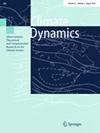在CMIP6 HighResMIP多模式综合中评估北太平洋信风前兆对ENSO的未来影响
IF 3.7
2区 地球科学
Q2 METEOROLOGY & ATMOSPHERIC SCIENCES
引用次数: 0
摘要
厄尔Niño南方涛动(ENSO)作为最大的耦合气候模态之一,影响着数百万人的生计和生态系统的生存。因此,在人为气候变化的影响下,ENSO预计会如何表现是一个需要研究的重要问题。在本文中,我们分析了ENSO特定特征的未来预测,并结合了一个已建立的前兆子集-信风充注和北太平洋经向模态(TWC/NPMM)。我们通过来自cmip6 -高分辨率模型比对项目(HighResMIP)的协议驱动集成的三组实验来研究它。即:(1)1950年代恒定辐射强迫的实验,(2)现在(1950 - 2014)和(3)规定辐射强迫增加的未来(2015-2050)气候的实验。本文首先通过计算热中心指数(CHI)的面积、振幅和经度,探讨ENSO事件的当前和预测空间特征。我们看到,在存在和不存在外部强迫的情况下,由TWC/ npmm驱动的事件始终更强;然而,随着人为强迫的增加,所有ENSO事件的范围都在增加。由于TWC/NPMM-ENSO关系已被证明影响ENSO的振荡行为,我们通过计算其信号的连续小波变换(CWT)上的chi -类比指标来分析ENSO的频率。通过这种新方法,我们发现ENSO在整体上以不同的频率振荡,其振荡行为随时间和模型的不同表现出不同程度的随机性。然而,我们没有看到ENSO振荡行为和TWC/NPMM-ENSO关系的未来趋势的一致迹象。本文章由计算机程序翻译,如有差异,请以英文原文为准。
Assessing the future influence of the North Pacific trade wind precursors on ENSO in the CMIP6 HighResMIP multimodel ensemble
Abstract The El Niño Southern Oscillation (ENSO), as one of the largest coupled climate modes, influences the livelihoods of millions of people and ecosystems survival. Thus, how ENSO is expected to behave under the influence of anthropogenic climate change is a substantial question to investigate. In this paper, we analyze future predictions of specific traits of ENSO, in combination with a subset of well-established precursors—the Trade Wind Charging and North Pacific Meridional Mode (TWC/NPMM). We study it across three sets of experiments from a protocol-driven ensemble from CMIP6—the High Resolution Model Intercomparison Project (HighResMIP). Namely, (1) experiments at constant 1950’s radiative forcings, and (2) experiments of present (1950–2014) and (3) future (2015–2050) climate with prescribed increasing radiative forcings. We first investigate the current and predicted spatial characteristics of ENSO events, by calculating area, amplitude and longitude of the Center of Heat Index (CHI). We see that TWC/NPMM-charged events are consistently stronger, in both the presence and absence of external forcings; however, as anthropogenic forcings increase, the area of all ENSO events increases. Since the TWC/NPMM-ENSO relationship has been shown to affect the oscillatory behavior of ENSO, we analyze ENSO frequency by calculating CHI-analogous indicators on the Continuous Wavelet Transform (CWT) of its signal. With this new methodology, we show that across the ensemble, ENSO oscillates at different frequencies, and its oscillatory behavior shows different degrees of stochasticity, over time and across models. However, we see no consistent indication of future trends in the oscillatory behavior of ENSO and the TWC/NPMM-ENSO relationship.
求助全文
通过发布文献求助,成功后即可免费获取论文全文。
去求助
来源期刊

Climate Dynamics
地学-气象与大气科学
CiteScore
8.80
自引率
15.20%
发文量
483
审稿时长
2-4 weeks
期刊介绍:
The international journal Climate Dynamics provides for the publication of high-quality research on all aspects of the dynamics of the global climate system.
Coverage includes original paleoclimatic, diagnostic, analytical and numerical modeling research on the structure and behavior of the atmosphere, oceans, cryosphere, biomass and land surface as interacting components of the dynamics of global climate. Contributions are focused on selected aspects of climate dynamics on particular scales of space or time.
The journal also publishes reviews and papers emphasizing an integrated view of the physical and biogeochemical processes governing climate and climate change.
 求助内容:
求助内容: 应助结果提醒方式:
应助结果提醒方式:


